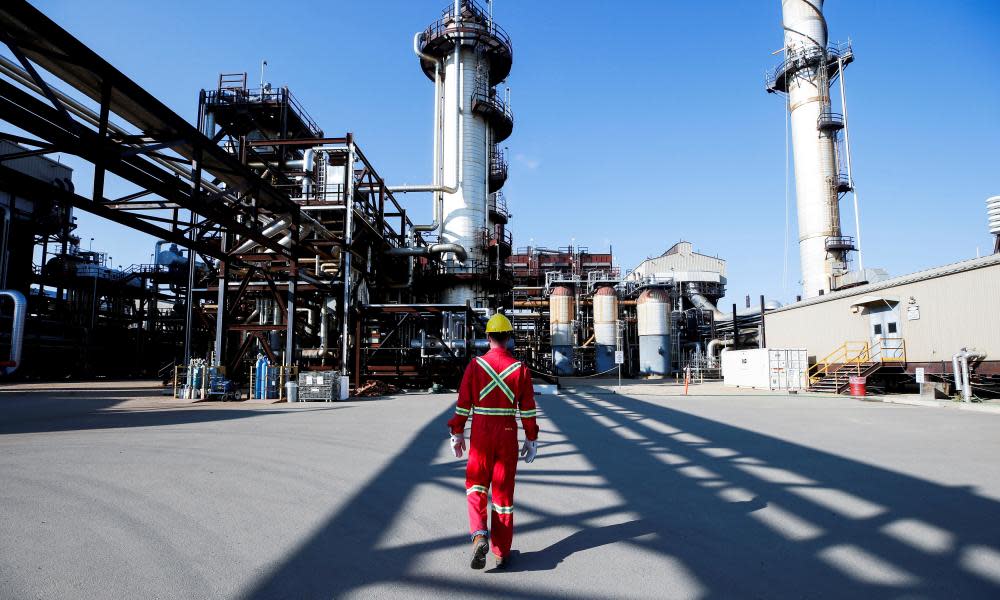What is carbon capture, usage and storage?

The UK government, along with many other governments around the world, is placing a lot of faith in carbon capture and storage, the technology that can keep carbon dioxide emissions from entering the atmosphere.
But does it work, and how can we afford it?
What is carbon capture and storage (CCS)?
The components of CCS have been around for decades now: it’s a group of technologies that can capture the carbon dioxide produced by major factories and power plants – preventing them from reaching the atmosphere and contributing to global heating – then transport them, bury them or reuse them. The key aim is to stop the CO2 escaping into the atmosphere and exacerbating the climate crisis.
Related: Fears that UK’s net zero strategy will be blown off course by oil and gas pressures
In most versions, the preliminary step involves fitting factory chimneys with solvent filters, which trap carbon emissions before they escape. The gas can then be piped to locations where it can be used or stored. Most carbon dioxide will be injected deep underground – where fossil fuel gas comes from in the first place – to be stored where it cannot contribute to the climate crisis. This can be part of a process called “enhanced oil recovery”, where CO2 is pumped into an oilfield to force out the remaining pockets of oil that would otherwise prove difficult to extract.
But some of the CO2 could be used to help make plastics, grow greenhouse plants or even carbonate fizzy drinks.
Why do we need carbon capture?
According to the IEA, CCS projects could reduce global carbon dioxide emissions by almost a fifth and reduce the cost of tackling the climate crisis by 70%. One of the key reasons CCS is necessary is because heavy industry – fertiliser producers, steel mills and cement makers – would be difficult and expensive to adapt to run on cleaner energy.
Where is carbon capture technology being used?
There are several CCS projects now operating commercially, but nowhere near enough to clean up the world’s carbon emissions. The early forerunners are in the US, Canada, Norway (which aims to be an international leader in the field) and China.
Related: Jeremy Hunt accused of ‘£20bn gamble’ on nuclear energy and carbon capture
The UK government has committed £20bn over the next 20 years to developing CCS. In Abu Dhabi, energy company Adnoc has begun a drilling campaign at Fujairah for a project that plans to turn captured carbon dioxide into rock.
According to the International Energy Agency, CCS facilities currently capture almost 45 megatonnes of CO2 globally, but this needs to increase. “CCS deployment has been behind expectations in the past, but momentum has grown substantially in recent years, with approximately 300 projects in various stages of development across the CCS value chain.”
Is the process expensive?
Although carbon capture and storage technology is expensive at present, within a few decades it is likely to come down sharply in price, according to a study published earlier this year, which argues that the companies that profit from extracting fossil fuels – oil, gas and coal producers around the world – should be paying for an equivalent quantity of carbon dioxide to be stored geologically as a condition of being allowed to operate.
Related: Sunak to focus on carbon capture and mini-nuclear reactors in energy policy
Under a “carbon takeback obligation”, all fossil fuels extracted or imported into a nation or group of nations would be offset by storing underground an amount of carbon dioxide equivalent to that generated by that fuel. Phased in over time, it could be used to store 100% of emissions by 2050, to help the world reach net zero.
In reality, this plan is pretty unlikely to go ahead. Instead, governments are crossing their fingers that the costs will come down as the technology evolves.

 Yahoo News
Yahoo News 
